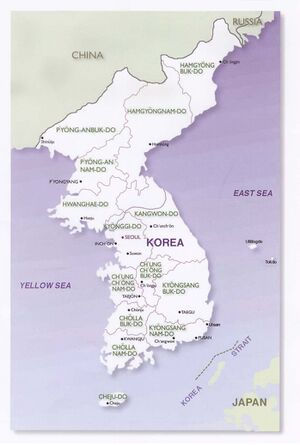XO Korea/Introduction
Introduction
Introduction
XO Korea is a small civil community intended to integrate Vision 2030 Plan of the Korean government, OLPC: One Laptop Per Child, FEA: Federal Enterprise Architecture of the US government, and open source communities such as Mozilla. XO Korea was started by a few Korean citizens, most of them residing in the Jejudo island of Korea.
We are just a few citizens. And, who we are is quite simple, mostly farmers and fishers. But, what we are doing is not so simple.
Most of our projects are based on OLPC and its variations; XO Korea/Korea 2030 Plan, XO Korea/XO Variations, XO Korea/Open Enterprise Architecture and XO Korea/Local Communities etc.
Via OLPC and its variations, we pursue a kind of World Automation based on Open Knowledge Communites. So, it's quite clear that we are pursuing Worldwide Knowledge Base on OLPC;more organized than wikipedia, but quite less structured than current school-driven educational systems.
We are, just conceptually, disassembling every nation into more than 300,000 social sections (a social unit producing values); then, we
- write XO Korea/Learning Outcomes for every social section,
- write the work-flow of each social section,
- establish relationships among those social sections worldwide, and
- applying our OEA after extending FEA: Federal Enterprise Architecture into Open Enterprise Architecture; Open, Global and both public and private(market) Areas.
As an example for our approaches to private sectors, we are now analyzing the work flow of a governmental banking system of Korea (Korea Industrial Bank) to make knowledge base, to draw workflows, and to automate each division and each desk of the bank. After analyzing and programming those work flows, we expect only one-tenth (1/10) of the current human resources be enough to run the entire bank, resulting much better financial achievements, not to mention of every child of the world learning every detail of how a bank operates.
Also, we are to simulate all divisions of the Korean governments, based on FEA: Federal Enterprise Architecture. For example, we are analyzing the work flow of XO Korea/Cenral Government/the Ministry of Construction & Transportation to test the possibility of running the organization with only one-tenth (1/10) of the current human resources as is the case of the bank above.
For this purpose, we are;
- analyzing the entire social sections of a nation (for example, we classified the Korean government into more than 150,000 seperate sections and extracted more than 80,000 functions from those 150,000+ sections. Each section performs some of the 80,000+ functions and each function is shared by more than 1 section(s))
- writing the knowledge base and the work flows of each section using workflow languages such as XO Korea/YAWL
- programming the work flow using various toolkits (especially Python-related ones)
But, our programming activities for those workflows itself is now enough to automate social entities such as governments (those entities depending on repetitive and spriritual labors).
We need two more conditions;
- the 1/10 human labors should be highly educated with Information Technologies and each be collaborate with other globally, that's exactly what OLPC pursues, as long as our understanding.
- not only governments or business entities, but customers' activities also should be automated. That is, all citizens should be equipped with some state-of-art hardwares and softwares. We think XO (and its variations) is exactly that kind of machine.
It's like client/server architecture. Our government modules may be regarded as server modules and those hardwares and softwares of customers as client modules. Of course, it's not a perfect explanation. Because, in our system architecture, every server is a client to other servers and every client is a server to other clients.
For every citizen of the world, XO Korea plans to provide some XO-based hardwares, softwares and server related modules. Some of them are;
- Hardwares
- XO Smartphone on linux and other open-source softwares. We call it XO Korea/XO Phone.
- XO Korea/Global Mesh Network: linking everyone to everyone in the world
- Input & Output Book: notebook (or laptop) type display and keyboard units. We call it XO Korea/IO Book.
- Softwares
- XO Korea/OpenOffice: MS Office compatible on open source architecture
- XO Korea/Toolkits: programming tools.
- independent web servers with the features of;
- XO Korea/Wiki
- XO Korea/Moodle
- a few XO Korea/Semantic Web based programs
In a near future, every division of the Korean government will be closely collaborating with other domestic and foreign governmental divisions (or organizations and personnels). Via RSS, RDF, ATOM and other technologies, a change in a division of the Korean government will be notified by other divisions of domestic and foreign nations in real time.
In summary, XO Korea is establishing;
- XO Korea/XO Phone: much smaller OLPC.
- XO Korea/Open Enterprise Architecture: the relationship between OEA and FEA is like that between Unix and Linux. OEA is an open (rather than closed), global (rather than a national wide) and total (rather than public only) Enterprise Architecture.
See also;
- XO Korea Global Network
- Some other projects
Currently (25 April, 2007), XO Korea is a small like-minded community, located in the Jejudo Island, and has not yet publicly announced its agenda.
XO Korea is now preparing a number of presentations for various governmental and business organizations in Korea, starting 15 May, 2007. After a few presentations and public announcement, we hope to start OLPC activities in Korea with the establishment of OLPC Korea (or XO Korea).
Coming soon...
환영합니다 | Portal | XO Korea | Deployment | Content | Hardware | Software | Mesh Network | Ethics | LOS | XO City | Accreditation | Consortium
XO Service is an organization to provide XO related services such as replacing XO or developing/translating Activities. That is; Because XO is a very robust machine, we don't expect frequent repair services and don't prepare a national wide service centers. As each school and other organizations deploying XOs will have some extra machines (maybe 100:1 ratio), it may be enough to collect damaged XOs once a month national wide.
The main focus of XO Service is on developing activities, writing content, and establishing frameworks and architectures, not to mention of maintaining National Mesh Network. We hope there will be about 50,000,000 XO and its variations in Korea in 3~5 years. Service plans for XO is set on this estimation.
Distributing XOs
Fortunately for Korean people, Shanghai China is very near to the Korean peninsula, only about 500 km on the sea. Therefore, the XO logistic cost of Korea will be the lowest among all over the world except China itself, which will not deploy XO.
Among 50,000,000 units of XO and its variations, we estimate about 7,000,000 XOs and about 23,000,000 Larger XOwill be exported from China, and the other about 13,000,000 XO Smartphone will be produced in Korea. As each XO and its peripherals will weigh about 1.5 kg, the shipping cost for the total weight of 15,000,000 kg (15,000 tons) will be added to the price of each XO unit. Maritime transportations between Shanghai, China and major ports in Korea are;
- Shanghai <-> Incheon
- Shanghai <-> Mokpo
- Shanghai <-> Busan
Replacing damaged XOs
XO Service will collect damaged XOs on a regular basis such as biweekly or monthly, and send them to Quanta for reassembly. Because Korea has well established logistic systems, it is not necessary to establish another logistic system for XO only. At present, it is difficult to estimate how many XOs will be damages among 100 or 1,000 units. We are now contacting a few logistic companies to get lowest but stable transportation services, and expect the very company distributing XOs will take in charge of collecting them also.
Developing Activities (Applications)
XO Korea will just support and participate in Activity Developers' Communities.
Establishing frameworks and architectures: OEA - Open Enterprise Architecture
Maybe, these are the peculiar tasks of XO Korea, establishing OEA. Briefly speaking, OEA is open source FEA, enterprise architecture not just for the USA, but for all nations worldwide. The purpose of OEA is;
- to establish common framework for developing applications,
- to automate repetitive office works,
- for citizens to participate in software engineering, programming, and debugging activities,
- for developers to share codes, DB, and systems etc, and;
- for citizens to monitor the workflow of each division/function via the web in real time.
Ultimately, our OEA is expected to increase the labor productivity of Korea more than twice the present.
Governmental Architecture
There are about 1,000,000 governmental employees in Korea, and XO Korea will provide about 1,000,000 Larger XOs and about 10,000 Governmental Servers for governmental organizations. Those Governmental Servers will host some OEA applications for governmental services.
For this purpose, we have classified all governmental services into more than 80,000 functions provided by 150,000+ hierarchical sections. We hope to establish a Complete Virtual Government which supplements (rather than substitute) the real Korean government. Anyone will be able to monitor, to participate in, and to debug all governmental activities in real time.
See XO_Korea/Central_Government/Introduction for details.
Business Architecture
There are about 23,000,000 private employees in Korea, and, approximately, XO Korea will provide 13,000,000 Larger XOs, 10,000,000 XO Smartphones, and about 130,000 XO Korea/Business Servers for private entities. Those Business Servers will host some OEA applications for business services. See labors for details.
For this purpose, we have classified all business services into more than 150,000 functions provided by 300,000+ hierarchical sections. We hope to establish a Complete Virtual Business Entities which supplements (rather than substitute) the real business entities. Anyone will be able to monitor, to participate in, and to debug all business activities in real time. However, our approach to business sections is different from that to governmental sections. We are Really establishing about 300,000 business entities on the web (exactly specking, on Business Servers) to which everyone can participate in as CEO, CFO, officers, and floor workers etc. They will produce real products and services, sell them, and make profits. Even more, shares and debts issued by those entities are expected to be traded in XO Korea/Open Exchange.
See XO_Korea/Business/Introduction for details.
Educational Architecture
We completely agree to the constructionists' ideas. All we should do is just to establish an environment for children to learn learning with minimum interference. The core of the environment is, we think, a library, not a normal one but quite a new one. The content below is about this new library system we are establishing. It's Moodle. Currently there are about 30,000 large or small schools and colleges in Korea for about 17,000,000 students. As we estimate One XO Korea/School Servers for One Hundred Students, we needs about 170,000 XO Korea/School Servers.
For the deployment plan in detail, see XO_Korea/Education/Introduction.
Research Architecture
We have classified all research fields in Korea into about 150,000 categories, and allocate One Moodle Server for each field. So, there will be about 150,000 virtual or real servers for R&D activities in Korea.
The Research Division of XO Service is in charge of managing those about 150,000 categories.
For the deployment plan in detail, see XO_Korea/Research/Introduction.
Public Architecture
This architecture is for both non-governmental and non-business activities and organizations in Korea, such as associations, governmental corporations, and foundations etc. At the date of April 30, 2007, there are about 50,000~70,000 such organizations, and, in principle, we will allocate One server for each of them.
The Public Division of XO Service will take in charge of the maintenance of those servers, providing required applications.
For the deployment plan in detail, see XO_Korea/Public/Introduction.
Maintaining national mesh network
As we plan to distribute more than 40,000,000 XO and its variations in Korea, they will automatically compose a wireless mesh network covering the entire nation, Korea. We hope this network will be used for data, voice, and video communications for Korea as well as the globe.
The Mesh Network Division of XO Service will take in charge of the maintenance of those servers, providing required applications.
For the deployment plan in detail, see Korean Mesh Network.
The plan of XO Korea is quite simple; following the OLPC Foundation, but a few steps ahead. Is it curious or nonsense? Yes, it's curious and nonsense. Though following the core ideas of the OLPC Foundation, we will steps ahead in deploying XO, testing next generations of XO, and its variations.
Approximately, until 2010, we plan to provide about 10,000,000 XO original types, about 20,000,000 Larger XOs, and about 30,000,000 XO Smartphones for Koreans only.
As System On Chip smartphone which has all features of XO needs a few years' R&D activities, we hope to deploy XO Korea/XO Phone instead of it for a while.
Hardware
We hope to distribute XO and its variations from early 2008', and to reach full distribution until the end of 2010'.
School XO Deployment
- See XO Korea/Education/Pre-primary School for detailed information about deployment in pre-primary schools
- See XO Korea/Education/Elementary School for detailed information about deployment in elementary schools
- See XO Korea/Education/Secondary School for detailed information about deployment in secondary schools
- See XO Korea/Education/Higher Education for detailed information about deployment in colleges and graduate schools
- See XO Korea/Education/Special Education for detailed information about deployment in special purpose schools
Government XO Deployment
- See XO Korea/Government/Central Government for detailed information about deployment
- See XO Korea/Government/Local Governments for detailed information about deployment
- See XO Korea/Government/Public Companies for detailed information about deployment
Business XO Deployment
- See each business category in XO Korea/Table_of_Contents page for detailed information about deployment in business sectors
Public Deployment
- See XO Korea/Public Sectors/Introduction for detailed information about deployment in public sectors (both non-governmental and non-private organizations)
Software (Activities) Development Plans
What kinds of software and Activities are necessary for schools, governments, business, and other organizations? When and how to distribute? Presumably, from this summer (2007')
Activities for School
Activities for Governments
Activities for Business
Activities for Public Organizations
Content Writing Plans
What kinds of content are necessary for schools, governments, business, and other organizations? When and how to distribute?
Content for School
Content for Governments
Content for Business
Content for Public Organizations
Open Enterprise Architecture
How and when to integrate software (Activities) and content of various organizations into Open Enterprise Architecture?



